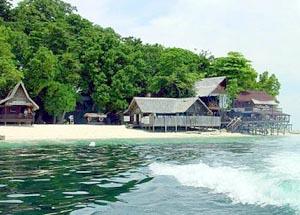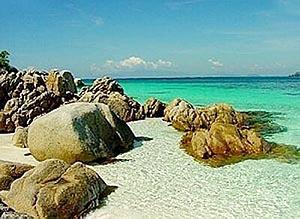|
|
Diverse dive spots in Malaysia
By
MICHAEL D’OLIVEIRO
It’s peak season for diving now and dive resorts will be
bracing themselves for the horde of scuba-divers descending on them.
Islands like Sipadan, Redang and Tioman are familiar names, but do we really know where
they are? Here’s a geographical guide of the best diving spots.
Malaysia’s abundant islands can be divided into four distinct groups - Borneo,
Tioman, the Northeast and Straits.
Borneo
The islands around Sabah are renowned for attracting seasoned
divers from around the world. Few realise that popular Pulau Layang-Layang is located
167km out in the South China Sea. It is, in fact, a giant atoll, and features great
aquatic life along with a magnificent 1,875m seawall. Hammerhead sharks are a key
attraction.
Southeast of the state is Pulau Sipadan. Calm waters and stunning wall reefs provide an
amazing variety of aquatic life and pelagics. The diversity is such that Jacques-Yves
Cousteau declared it one of the most beautiful islands he’d ever seen. Around this
national gem are also the sister islands of Mabul, Kagilan and Ligitan.

|
Reputation tarnished by the hostage-taking incident, Sipadan is
becoming safe place to come back to because of the beefed-up security. |
If you don’t want to leave too far from Kota
Kinabalu, Tunku Abdul Rahman Park (TAR Park) is an ideal divespot. Pulau Labuan offers
wonderful wreck diving opportunites while Turtle Island Park, which lies to the northeast
of Sabah, is famous for obvious reasons.
Sarawak boasts a few gems of its own too. Off Kuching are the remarkable Pulau Satang and
Pulau Talang-Talang which are both natural and strictly protected sanctuaries for turtles.
In fact, no overnight visitors are allowed on these islands.
Tioman
Located off Johor, this group comprises Pulau Tioman, Pulau Besar, Pulau Aur and its tiny
but idyllic offshoot, Pulau Dayang. Tioman is our third largest island and even boasts its
own airstrip. As such, dive centres are scattered in each corner while divers are exposed
to a myriad of excellent diving sites around it.
Pulau Chebeh (located northeast) was where a group of divers and I spotted a 15m Giant
Manta on our very last dive. Of the smaller islands, Dayang is perhaps the best as
it’s still a pristine paradise. Its idyllic waters are popular with open water dive
students from Malaysia and Singapore.
Further south are Pulau Besar and Pulau Tinggi, with the latter noted for its ancient
volcanic peak.
Northeast
For ravishing beaches and beautiful coral, nothing in Malaysia can match the Northeast
group of islands. We begin with Kelantan-controlled Pulau Perhentian in the north. Rich in
coral, Perhentian (it is actually two islands: Perhentian Besar and Perhentian Kecil) is
also famous for attracting turtles to its beaches. Off Trengganu, Pulau Lang Tengah and
Pulau Redang follow. Both are popular but Redang’s rich coral diversity and pelagic
attractions have led to major resorts being built on it. An airstrip is being built soon
to cater for the increasing demand from local and international arrivals.

|
| The water around
Pulau Perhentian is so pristine, divers and snorkellers gain continuous delight. |
Pulau Kapas and Tenggol complete the chain with the
latter already having its own airstrip. The rocky underwater terrain is a distinct feature
here. In general, the reputation of the Northeast islands have only been tarnished by the
state government’s restrictions on beachwear.
Straits/West Coast
Although primarily noted for its availability when monsoons strike the rest of the nation,
the Straits group of islands provide choppy waters and a different experience. Starting
with Langkawi (a group in itself) diving can be expensive due to the remoteness of good
dive sites. Also, the island’s resort status makes the cost prohibitive as a mere two
dives can cost up to RM280 or more. Pulau Payar further south probably has the best sites.
Pulau Perak is even further out, but boasts unusually blue waters and a chance of sighting
larger pelagics. Right in the middle of the straits, Pulau Jarak has better visibility due
to its remoteness. Dolphins and sailfish have been sighted here.
A better choice is Pulau Sembilan which lies further south, near Lumut. Of course, there
are many more islands in between that are probably well-kept secrets to everyone but the
most hardcore divers. Divers would do well to explore as many as possible here before
setting out for foreign shores.
Malaysia offers no shortage of diving choices. It is the combined uniqueness of our
islands that makes them so attractive. Just like our cultural diversity.
RELATED STORY
Dive into History
TOUR SPECIAL
5D/4N Sipadan-Mabul-Kapalai
Diving Holiday
Source: The
Star
BACK
TO LEISURE PAGE
|
